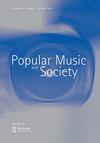White Stripes, White Rock: The Uncontested Blues Appropriations of the White Stripes
IF 1
3区 艺术学
0 MUSIC
引用次数: 0
Abstract
ABSTRACTDespite the prevalence of the cultural appropriation debate in popular music discourse, white, popular rock band, the White Stripes, appropriated African-American Delta blues culture, particularly from Son House and his song “Death Letter Blues,” without causing contestation. Appropriation of Black culture has occurred ubiquitously throughout recent music history, causing widespread contestation due to power disparity and misrepresentation. Through reviewing literature regarding cultural appropriation, and semiotically analyzing the band’s 2003 performance of “Death Letter” at Sydney’s Livid Festival, we find that the White Stripes’ intentional methods of respectful representation and stylistic disguise mitigated the perception of cultural appropriation in their performance. We posit that the band emulated a pre-established process of transculturation whereby Delta blues traits were absorbed into the 20th century evolution of rock music.KEYWORDS: Bluescontestationcultural appropriationSon Housethe White Stripestransculturation Disclosure StatementNo potential conflict of interest was reported by the author(s).Notes1. For further reading on the racialization of blues, and its entry into white audiences and markets, see also Hamilton’s In Search of the Blues and Adelt’s Blues Music in the Sixties.2. The video recording of the “The White Stripes—Live in Sydney” was accessed via YouTube, which is featured in a compilation video of the band’s whole set at Livid publicly uploaded by user J C. We can assume that the recorded set was originally broadcasted on Channel V due to the watermark embedded in the video. “Death Letter” appears at 19:26–26:46.3. Paramusical meaning exists alongside music, it is “semiotically related to a particular musical discourse” (Tagg 597).4. Meaning is constructed via connotation (to signify by implication or association) and denotation (to signify lexically). While musical meaning remains more denotative, paramusical meaning can be generated via signifiers which connote discourse that exists alongside the music (Tagg 585–96).Additional informationNotes on contributorsCharlotte MarkowitschCharlotte Markowitsch is currently undertaking a PhD with the School of Media and Communication at RMIT University. While her broader interests center around rock and popular music studies, Charlotte’s research has touched on cultural engagement, appropriation, race, and blues and rock history. Currently, Charlotte’s research project investigates aesthetic representations of identity, particularly masculinity, in Australian rock music culture.Sebastian Diaz-GascaSebastian Diaz-Gasca is an audio engineer, music producer, and lecturer in Music Industry at the School of Media and Communication at RMIT University. His research ranges from ludomusicology, musical narratology, videogame studies, music production, ethnomusicology, and Latin American social studies. Sebastian’s ludomusicological (game music) research focuses on the paraludical relationships between audiences and videogame music, and the personal, social, and economic forces which surround these relationships. He has studied the use of game music outside of gameplay, including the role of videogame cover bands in the social interactions amongst audiences.白色条纹,白色摇滚:无可争议的蓝调对白色条纹的挪用
摘要尽管流行音乐话语中存在文化挪用的争论,但白人流行摇滚乐队white Stripes对非裔美国人三角洲布鲁斯文化的挪用,尤其是从Son House和他的歌曲《Death Letter blues》中挪用,却没有引起争议。在最近的音乐史上,黑人文化的挪用无处不在,由于权力悬殊和歪曲而引起了广泛的争论。通过回顾有关文化挪用的文献,并对2003年在悉尼Livid Festival上演出的《Death Letter》进行符号学分析,我们发现White Stripes乐队有意采用尊重的表现方式和风格上的伪装,减轻了他们在表演中对文化挪用的感知。我们假设乐队模仿了一个预先建立的跨文化过程,即三角洲布鲁斯的特征被吸收到20世纪摇滚音乐的演变中。关键词:布鲁斯竞赛;文化拨款;儿子之家;;;;;要进一步了解蓝调的种族化,以及它进入白人听众和市场的情况,请参见汉密尔顿的《寻找蓝调》和阿德尔特的《60年代蓝调音乐》。《The White Stripes-Live in Sydney》的录制视频是通过YouTube获得的,在用户J . C.公开上传的乐队在Livid的整套录制视频中,我们可以假设该录制集最初是在V频道播出的,因为视频中嵌入了水印。"遗书"出现在19:26-26:46.3。辅助音乐意义伴随着音乐而存在,它“在符号学上与特定的音乐话语相关”(标签597)。意义由内涵(通过暗示或联想来表示)和外延(通过词汇来表示)构成。虽然音乐意义仍然是外延的,但可以通过暗示与音乐一起存在的话语的能指来产生音乐意义(Tagg 585-96)。charlotte Markowitsch目前正在RMIT大学媒体与传播学院攻读博士学位。虽然她更广泛的兴趣集中在摇滚和流行音乐研究上,但夏洛特的研究涉及文化参与、挪用、种族、蓝调和摇滚历史。目前,夏洛特的研究项目调查身份的审美表现,特别是男性气质,在澳大利亚摇滚音乐文化。Sebastian Diaz-Gasca是一名音频工程师、音乐制作人,也是RMIT大学媒体与传播学院音乐产业讲师。他的研究范围包括音乐音乐学、音乐叙事学、电子游戏研究、音乐制作、民族音乐学和拉丁美洲社会研究。Sebastian的游戏音乐研究侧重于观众和电子游戏音乐之间的关系,以及围绕这些关系的个人、社会和经济力量。他研究了游戏音乐在游戏玩法之外的应用,包括电子游戏翻唱乐队在用户社交互动中的作用。
本文章由计算机程序翻译,如有差异,请以英文原文为准。
求助全文
约1分钟内获得全文
求助全文
来源期刊

POPULAR MUSIC AND SOCIETY
MUSIC-
CiteScore
1.10
自引率
0.00%
发文量
33
期刊介绍:
Popular Music and Society, founded in 1971, publishes articles, book reviews, and audio reviews on popular music of any genre, time period, or geographic location. Popular Music and Society is open to all scholarly orientations toward popular music, including (but not limited to) historical, theoretical, critical, sociological, and cultural approaches. The terms "popular" and "society" are broadly defined to accommodate a wide range of articles on the subject. Recent and forthcoming Special Issue topics include: Digital Music Delivery, Cover Songs, the Music Monopoly, Jazz, and the Kinks. Popular Music and Society is published five times per year and is a peer-reviewed academic journal supported by an international editorial board.
 求助内容:
求助内容: 应助结果提醒方式:
应助结果提醒方式:


